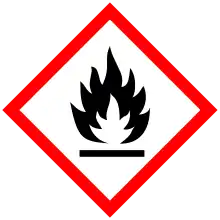Hexamethylcyclotrisiloxane
Hexamethylcyclotrisiloxane is the organosilicon compound with the formula [(CH3)2SiO]3. It is a colorless or white volatile solid. It finds limited use in organic chemistry. The larger tetrameric and pentameric siloxanes, respectively octamethylcyclotetrasiloxane and decamethylcyclopentasiloxane, are of significant industrial interest,[1] whereas 1,000–10,000 tonnes per year of the trimer is manufactured and/or imported in the European Economic Area.[2]
 | |
| Names | |
|---|---|
| IUPAC name
2,2,4,4,6,6-hexamethyl-1,3,5,2,4,6-trioxatrisilinane | |
| Other names
hexamethyltrisiloxane, dimethylsiloxane trimer, D3 | |
| Identifiers | |
3D model (JSmol) |
|
| ChemSpider | |
| ECHA InfoCard | 100.007.970 |
| EC Number |
|
PubChem CID |
|
| UNII | |
CompTox Dashboard (EPA) |
|
| |
| |
| Properties | |
| C6H18O3Si3 | |
| Molar mass | 222.462 g·mol−1 |
| Appearance | Colorless or white solid |
| Density | 1.02 g/cm3 |
| Melting point | 64 °C (147 °F; 337 K) |
| Boiling point | 134 °C (273 °F; 407 K) |
| Hazards | |
| GHS pictograms |   |
| GHS Signal word | Warning |
| H228, H315, H319, H335 | |
| P210, P240, P241, P261, P264, P271, P280, P302+352, P304+340, P305+351+338, P312, P321, P332+313, P337+313, P362, P370+378, P403+233, P405, P501 | |
Except where otherwise noted, data are given for materials in their standard state (at 25 °C [77 °F], 100 kPa). | |
| Infobox references | |
Structure and reactions
Hexamethylcyclotrisiloxane adopts a planar structure and is considered strained.[3][4] It reacts with organolithium reagents to give, after hydrolysis, dimethylsilanols:
- 1/3 [(CH3)2SiO]3 + RLi → RSiMe2OLi
- RSiMe2OLi + H2O → RSiMe2OH + LiOH
Safety and environmental considerations
The LD50 for the related pentamer (D5) is >50 g/kg in rats.[1]
References
- Moretto, Hans-Heinrich; Schulze, Manfred; Wagner, Gebhard (2005). "Silicones". Ullmann's Encyclopedia of Industrial Chemistry. Weinheim: Wiley-VCH. doi:10.1002/14356007.a24_057.
- "InfoCard – Hexamethylcyclotrisiloxane". ECHA. Retrieved 2018-07-20.
- Scott E. Denmark Christopher R. Butler. "Hexamethylcyclotrisiloxane". eEROS. doi:10.1002/047084289X.rn00784.CS1 maint: uses authors parameter (link)
- Brook, Michael A. (2000). Silicon in Organic, Organometallic and Polymer Chemistry. New York: Wiley. p. 262. ISBN 0-471-19658-4.
This article is issued from Wikipedia. The text is licensed under Creative Commons - Attribution - Sharealike. Additional terms may apply for the media files.